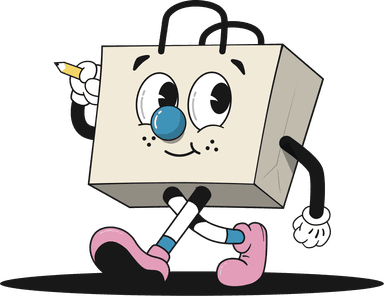Get access to exclusive updates, the latest news and the inside scoop 🍨

Marketing Budget Breakdown Tips
There are a few simple marketing budget breakdown tips that we would recommend utilising to discover the most effective ways of spending a budget.
Don't want to read the whole article? 😏Click here for chapters

Written by Madeleine
Marketing Budget Breakdown Guide 📖
We are in the age where following marketing budget breakdown tips is recognised as the foundation of ecommerce business growth and as a Shopify agency, we thought we'd shed a little light on the subject for merchants on the platform.
It’s only natural that marketers and merchants on platforms like Shopify are having to devote their time and resources to determine exactly how each penny will be spent, following well-advised marketing budget breakdown tips so that they can optimise their business’ ROI.
However, this can be difficult to achieve if you are just launching a new campaign for the very first time and have no idea where to start when it comes to breaking down your store's marketing budget.
If you do not have valuable historical data to rely on this can make the task of following any marketing budget breakdown tips especially difficult as you will be venturing into a brand new channel without any foundations or experience.
Never fear though as the way forward is to start by outlining a detailed budget based upon what you know in regards to your Shopify store and the goals in place.
From these insights, you will be able to gain knowledge from each investment that has been made and reap positive results when following the marketing budget breakdown tips as listed within today's guide.
Many online businesses may use a variety of metrics to determine their ROI such as; first-touch, last-touch, or multi-touch attribution.
Nonetheless, it’s important to understand that whichever one you choose the result will inform you of your best budget decisions so that you can allocate the correct budget and the most effective performing channels for your business.
However, before startup businesses on Shopify can gain access to valuable metrics, there are a few simple marketing budget breakdown tips that we would recommend utilising to discover the most effective ways of spending a budget:
N0.1: Campaign Planning and Content Creation (40-50%)
First up in today's guide of marketing budget breakdown tips for Shopify stores is the topic of campaign planning and content creation.
Before you can understand what returns you should witness from your marketing investments, you will first need to start with campaigns that are based upon your business goals.
Ideally, the goals of a company should map out each stage of the customer cycle. For example, if your goal is to build brand awareness, we would suggest investing in a campaign that differentiates your brand from its competitors, whilst offering core values for potential customers.
However, if your goal is to focus on customer retention and growth for your Shopify store, your campaign should be centred around keeping your customers happy and you can take that as one of today's marketing budget breakdown tips.
It's no surprise that customer satisfaction will lead to a surge in business growth if achieved correctly so, we’d say that this is well-deserving of a place within our guide to marketing budget breakdown tips for startups.
Whatever the objectives for your campaign, it is likely that content will serve as the crux for each one.
However, according to the Content Marketing Institute, only 32% of B2B marketers have a documented content strategy and only 88% of online marketers are using content as a part of their core marketing mix.
This is somewhat shocking for us here at Karmoon, as we know that digital content such as; blog posts, social media posts, YouTube videos, eBooks, infographics and the likes of others all have a role to play in the evolution of a brand and its story.
What's more bewildering to us is that ecommerce platforms such as Shopify focus on the content - customer relationship so, it is very surprising to learn that merchants still aren't making use of this strategy as much as they should be in 2021.
However, as effective as a content strategy can be, it would seem as though a successful method is only as strong as its approach to time and money well spent which is where the importance of following strong marketing budget breakdown tips come in to play.
Ultimately, this appraoch will solidify any brand, whether this may be on Shopify or another ecommerce platform, which will result in browsers becoming buyers who are well acquainted with the business from first introductions.
The first step in the customer journey should be geared towards converting browsers into satisfied consumers.
So, in addition to creating a scalable content creation process, you may need to seek out the services and expertise of vendors/ consultants to do this successfully. This will enable every business to refine the plans of the Shopify/ ecommerce store at hand.
Additionally, dedicated writers may be needed to produce content for you, but if your collateral needs exceed your marketing team’s capacity, you may need to hire a freelancer.
So, giving thought to checking in with some marketing budget breakdown tips may be required here to make sure that your business does not overspend.
N0.2: Paid Advertising (20-30%) 💰
The next topic in today's guide sorrounding marketing budget breakdown tips for stores on Shopify is paid advertising.
While much of the digital content produced depends on organic reach, reaching users via specific online outlets without paying for the privilege of paid advertising gives enterprises a head start in the market.
Shopify stores need to take advantage of marketing budget breakdown tips when it comes to paid advertising if they are hoping to establish a newfound market presence. Similarly, paid advertising is a great technique for an established business that is looking to enter an entirely new segment of the market.
Here’s a quick marketing budget breakdown example for paid advertising to explain how this method could be used effectively:
It should be noted that paid marketing can take many forms, be it; cost-per-click ads, social media ads, print ads, or even TV or radio commercials, all forms of paid marketing can assist a business.
On the other hand, unpaid marketing (also referred to as organic marketing) may take longer to reach the intended audience and desired outcome for your Shopify store.
So, going back to paid advertising, this method in our opinion would make ideal marketing for startups. With paid advertising, the channel that a business chooses to advertise on will be paid directly for access to that channels' user base.
However, if you do your research and follow the right marketing budget breakdown tips, you’ll know exactly which channels to invest in to reach your target audience and the goals set out for your business.
Typically, these outlets will provide the statistics that you’ll need to calculate the ROI of placing an ad with them. At the end of the day, an ad that costs money to place and then has another per click cost is only worth the investment if you are guaranteed to reach prospects with a high rate of conversion.
However, we should make it clear that paid advertising provides some of the most direct and immediate measures of ROI available and with this method, marketing for startups will be able to detect pound-for-pound which advertisement brought in the highest volume of conversions or revenue for the business.
So, going forward, you'll have a great idea of where you should be spending your money, making this one of the best marketing budget breakdown tips that we could provide for stores on Shopify.
Digital advertising is also extremely worthwhile, especially given the ease of publishing ads across some of the biggest channels on the internet.
Platforms such as; Facebook, LinkedIn, Instagram and YouTube are just some of the giants that offer excellent targeting options for eCommerce merchants in 2021. So, if you haven't already, why not check them out?
N0.3: Workplace Marketing (10%)
Your workforce is an extremely powerful part of your marketing arm, which is why workplace marketing consists of aligning every member of a team behind company goals through increased education and advocacy-strengthening efforts.
Therefore, it may require internal meetings, events, and marketing collateral for members of your Shopify business that sell employees on the company’s culture and goals, not to mention looping everyone in on the reasons behind the marketing budget breakdown tips that you are eager to follow.
Naturally, this won’t come without a price tag, however, we strongly believe that employees are well worth the investment.
Every Shopify business should encourage its workforce to build up their knowledge, motivation and morale, but going beyond this, internal goodwill can be a major force in attracting both new leads and new hires.
This can contribute towards the successful growth of a startup Shopify business, just like any number of sucessfully followed marketing budget breakdown tips could do.
To fully utilise workplace marketing, businesses should consider implementing an employee advocacy program, where the company can invest in morale-building, educational seminars or create free competition among departments.
In Layman’s terms, allowing the employee to market the business will aid your Shopify store to reach new audiences, whilst enticing its workforce on a personal level.
As an internal investment, the ROI can be measured by tracking the number of leads brought in via an employee advocacy program. With a robust marketing automation platform, companies can set social referral campaigns in place across major online channels and platforms.
These campaigns will then be able to track referrals and their corresponding responses.
This is also a great program to run for customer advocates as well, but if you’re in the process of launching, you may want to test the waters on your internal Shopify workforce before anything else.
N0.4: Software and Tools (10%) 🛠️
The fourth of our marketing budget breakdown tips sorrounds the software and tools used by your Shopify/ ecommerce store.
See, software and tools streamline and automate the essential tasks, saving the cogs behind the company precious time, money, and human resources. By taking advantage of software and tools, online businesses will be in a position to analyse and refine their marketing activities much more intuitively.
With the right marketing budget breakdown tips in place, the performance of every campaign run by your Shopify store, not to mention each asset pushed can be accessed.
Alongside this, key performance metrics can be tracked to determine the success of each effort (for both current and past campaigns) that result in clear ROI projections.
For each campaign, measurement strategies should be planned well in advance, as this information will be required to set up tracking.
So, before you move forward with this for your Shopify business, give some thought to the metrics that you’re going to need to track and measure and ensure that you have the right tools to do so.
We feel that it could also be helpful to share a list of valuable tools that can be utilised by any marketing team within today's guide to marketing budget breakdown tips:
An automation or engagement marketing platform that will help you streamline, automate, and measure your marketing tasks and workflows may increase operational efficiency and grow revenue at a faster rate for your business.
With an automation marketing or engagement marketing platform, businesses will even be able to increase demand, engage with consumers throughout the entire customer lifecycle and measure the effectiveness of each campaign on every single channel.
As we’re sure you know, a content management system (CMS) will provide an efficient means of letting the right individuals in your organisation publish and organise content across their presence on the web.
A customer relationship management (CRM) tool provides complete oversight and detailed recording of buyer interactions and touchpoints.
Simply put, businesses can track a customer’s progress through the use of sales funnels. This gives power back to the brand at hand, enabling a close analysis of what works best in each relationship.
Furthermore, syncing a marketing automation platform with a CRM tool has the power to improve sales and marketing alignment for stores on platforms like Shopify so that both teams are always up to date on each prospect’s interactions throughout the company.
A social media management platform is another great technique in marketing for startups as this allows for the management of social media campaigns by setting an editorial calendar.
Doing this will essentially allow each Shopify business to monitor real-time social media conversations about; the brand, its products and the industry that it resides in.
Thus, making the immediate identification of engagement a possibility, whilst analysing the impact of participation across each social platform.
Most importantly, these tools provide a company with the analytics and insight that businesses need to determine and improve their ROI.
Data will flow from place to place about your customers and even though some metrics will be able to be calculated manually, the general rule of thumb is that the bigger the marketing effort, the bigger the need for technology.
Why? Well, technology is designed to handle all data points so, it's there to help you out. The investment in the technology is an upfront portion of working out how it fits into your budget, but we'd say the bigger the Shopify business the more essential this is for establishments to pursue.
N0.5: Events (5-10%)
A corporate presence at large industry events can quickly deepen the market presence of any business on Shopify. Events are a great way to show prospects that a company is a real-world business with a unique identity.
Events, be it tradeshows, conventions, conferences, or roadshows, can be prime opportunities to show prospects and customers, in a personal setting, why your business matters.
So, here are some of our marketing budget breakdown tips for expenses generated by large industry events:
Costs can include; registration fees, travel expenses and of course collateral.
Hosting your event includes some of the costs listed above, however, it should be understood that venue rentals, catering, promotions, and other miscellaneous operating fees will be just some of the expenditures added to the list.
It’s fairly simple to track how many fruitful conversations result from in-person contact, as the impact of an industry event is measurable in several ways.
For instance, when prospects register for an event, visit a booth, or attend a session, a tangible lead is created right there and then!
In the thick of assessing marketing needs and trying to implement new campaigns, businesses often cannot see the forest through the trees.
But with a well-planned marketing budget breakdown method for your Shopify store, merchants will be able to relax and focus on each marketing task, knowing that they are building a strong foundation for their brand’s continued growth.
So, what are your thoughts on our marketing budget breakdown tips? Reach out and let us know.
If you’re actively looking to work with a Shopify agency designer or developer to assist you with your online store, we’d love to hear from you. Shoot us an email to get started!
Get Started with Shopify
Looking to get started with Shopify? Take advantage of Shopify's 14-day free trial, no credit card is required.
If you're actively looking to work with a Shopify agency designer or developer to assist you with your business, we'd love to hear from you. Get in touch to get started!
Want to read some more?
Have a look over more posts related to this one















